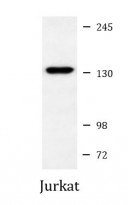ARG53993
anti-DBC1 antibody
anti-DBC1 antibody for ICC/IF,Immunoprecipitation,Western blot and Human,Mouse,Rat,Monkey
Cancer antibody; Cell Biology and Cellular Response antibody; Cell Death antibody
Overview
| Product Description | Mouse Monoclonal antibody recognizes KIAA1967 |
|---|---|
| Tested Reactivity | Hu, Ms, Rat, Mk |
| Tested Application | ICC/IF, IP, WB |
| Host | Mouse |
| Clonality | Monoclonal |
| Isotype | IgG1 |
| Target Name | DBC1 |
| Antigen Species | Human |
| Immunogen | Purified recombinant human DBC1 protein fragments expressed in E.coli |
| Conjugation | Un-conjugated |
| Alternate Names | KIAA1967; p30 DBC; p30DBC; DBC.1; DBC1; Cell division cycle and apoptosis regulator protein 2; DBIRD complex subunit KIAA1967; DBC-1; Cell cycle and apoptosis regulator protein 2; NET35; Deleted in breast cancer gene 1 protein |
Application Instructions
| Application Suggestion |
|
||||||||
|---|---|---|---|---|---|---|---|---|---|
| Application Note | * The dilutions indicate recommended starting dilutions and the optimal dilutions or concentrations should be determined by the scientist. | ||||||||
| Observed Size | 130 kDa |
Properties
| Form | Liquid |
|---|---|
| Purification | Affinity purified |
| Buffer | 0.1M Tris-Glycine (pH 7.4), 150 mM NaCl, 0.2% Sodium azide and 50% Glycerol |
| Preservative | 0.2% Sodium azide |
| Stabilizer | 50% Glycerol |
| Concentration | 1 mg/ml |
| Storage Instruction | For continuous use, store undiluted antibody at 2-8°C for up to a week. For long-term storage, aliquot and store at -20°C. Storage in frost free freezers is not recommended. Avoid repeated freeze/thaw cycles. Suggest spin the vial prior to opening. The antibody solution should be gently mixed before use. |
| Note | For laboratory research only, not for drug, diagnostic or other use. |
Bioinformation
| Database Links |
Swiss-port # Q8N163 Human Cell cycle and apoptosis regulator protein 2 Swiss-port # Q8VDP4 Mouse Cell cycle and apoptosis regulator protein 2 |
|---|---|
| Gene Symbol | CCAR2 |
| Gene Full Name | cell cycle and apoptosis regulator 2 |
| Background | Core component of the DBIRD complex,a multiprotein complex that acts at the interface between core mRNP particles and RNA polymerase II (RNAPII) and integrates transcript elongation with the regulation of alternative splicing:the DBIRD complex affects local transcript elongation rates and alternative splicing of a large set of exons embedded in (A + T)-rich DNA regions.Inhibits SIRT1 deacetylase activity leading to increasing levels of p53/TP53 acetylation and p53-mediated apoptosis.Inhibits SUV39H1 methyltransferase activity.As part of a histone H3-specific methyltransferase complex may mediate ligand-dependent transcriptional activation by nuclear hormone receptors. |
| Function | Core component of the DBIRD complex, a multiprotein complex that acts at the interface between core mRNP particles and RNA polymerase II (RNAPII) and integrates transcript elongation with the regulation of alternative splicing: the DBIRD complex affects local transcript elongation rates and alternative splicing of a large set of exons embedded in (A + T)-rich DNA regions. Inhibits SIRT1 deacetylase activity leading to increasing levels of p53/TP53 acetylation and p53-mediated apoptosis. Inhibits SUV39H1 methyltransferase activity. As part of a histone H3-specific methyltransferase complex may mediate ligand-dependent transcriptional activation by nuclear hormone receptors. Plays a critical role in maintaining genomic stability and cellular integrity following UV-induced genotoxic stress. Regulates the circadian expression of the core clock components NR1D1 and ARNTL/BMAL1. Enhances the transcriptional repressor activity of NR1D1 through stabilization of NR1D1 protein levels by preventing its ubiquitination and subsequent degradation. [UniProt] |
| Cellular Localization | Nucleus |
| Research Area | Cancer antibody; Cell Biology and Cellular Response antibody; Cell Death antibody |
| Calculated MW | 103 kDa |
| PTM | ATM/ATR-mediated phosphorylation at Thr-454 upon DNA damage promotes binding to SIRT1. Phosphorylation at Thr-454 promotes its sumoylation by switching the binding partner of CCAR2 from SENP1 to PIAS3. Acetylation at Lys-112 and Lys-215 by KAT8 prevents inhibitory binding to SIRT1 and increases its deacetylase activity. Genotoxic stress induces its sumoylation and sumoylation promotes the SIRT1-CCAR2 interaction which in turn inhibits SIRT1-mediated deacetylation of p53/TP53. Sumoylation leads to transcriptional activation of p53/TP53 by sequestering SIRT1 from p53/TP53. Desumoylated by SENP1. |
Images (3) Click the Picture to Zoom In
-
ARG53993 anti-DBC1 antibody ICC/IF image
Immunofluorescence: HeLa cells stained with ARG53993 anti-DBC1 antibody at 1:200 dilution.
-
ARG53993 anti-DBC1 antibody WB image
Western blot: Jurkat cell lysate stained with ARG53993 anti-DBC1 antibody at 1:500 dilution.
-
ARG53993 anti-DBC1 antibody IP image
Immunoprecipitation: HeLa cell lysates were immunoprecipitated and stained with ARG53993 anti-DBC1 antibody.








